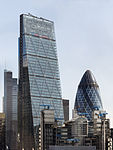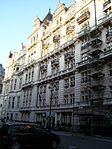Gurkha Memorial, London

The Memorial to the Brigade of Gurkhas on Horse Guards Avenue, Whitehall, London, was unveiled by Queen Elizabeth II on 3 December 1997. This was the first memorial to Gurkha soldiers in the United Kingdom, and was occasioned by transfer of their headquarters and training centre from Hong Kong to London in 1997. The sculptor was Philip Jackson, working from a statue of 1924 by Richard Reginald Goulden in the Foreign and Commonwealth Office, and the plinth was designed by Cecil Denny Highton.Two casts of Goulden's sculpture had previously been erected in locations in Nepal as World War I memorials to the Gurkhas, the first at Kunraghat in 1928 and the second at Birpur in 1930. The memorial in London is more than one and a half times the size of this model, so Jackson worked the figure up in his own style and from a living model, Captain Khemkumar Limbu. One of several inscriptions on the plinth is a quotation from Sir Ralph Lilley Turner, a former officer in the 3rd Gurkha Rifles.
Excerpt from the Wikipedia article Gurkha Memorial, London (License: CC BY-SA 3.0, Authors, Images).Gurkha Memorial, London
Whitehall Court, City of Westminster Covent Garden
Geographical coordinates (GPS) Address Nearby Places Show on map
Geographical coordinates (GPS)
| Latitude | Longitude |
|---|---|
| N 51.50509 ° | E -0.12503 ° |
Address
Whitehall Court
SW1A 2EF City of Westminster, Covent Garden
England, United Kingdom
Open on Google Maps











